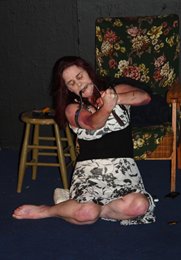Originally commissioned by the Drugs Awareness Board, Sean Ronan’s Sweet Dreams, Mr Heroin serves as a potent reminder, if one were needed in Dublin where the ghosts of heroin roam the streets daily, of the ruination that the drug causes in lives and communities.
Sweet Dreams, Mr Heroin is a two-scene, two actor play with each scene anchored by one cast member. Ronan’s objective is to show the effects of heroin from the vantage point of both the user and those who lose loved ones to heroin abuse. The performance begins with Ronan on stage on his own, wearing a skull cap and hoodie, delivering the monologue of a father who’s talking through the knot of emotions summoned by seeing his addict son Joey begging for change on a bridge in the Dublin city centre. This father’s pain is deeply internalised and slightly sentimental, quite unlike that of Paula (Suzanne Lakes), a woman at the deepest depths of withdrawal who features in Sweet Dreams, Mr Heroin’s second scene. We see the prostitute and addict's anguished rise from bed to what will be a pretty terrible day: it’s her estranged daughter’s First Holy Communion, but the ESB has shut off the electricity in her Pearse Street flat, and most troublingly, Paula is out  of heroin. Lakes is very impressive in a physically-demanding role that involves writhing, vomiting, weeping and a lot of talking on a mobile phone. We see so many stages of a drug addict’s condition in this scene: Paula’s wilful delusion that she’ll be well enough to attend the ceremony, her coy cleverness in pursuing her fix and most graphically, her unsettling physical need for the drug. Ronan also plays Leo, a pimp and drug dealer, and while one sometimes wished for a bit more subtlety in the portrayal of his sadistic relationship with Paula, this is a play that takes an unflinching look at heroin abuse – subtlety is perhaps a secondary concern.
of heroin. Lakes is very impressive in a physically-demanding role that involves writhing, vomiting, weeping and a lot of talking on a mobile phone. We see so many stages of a drug addict’s condition in this scene: Paula’s wilful delusion that she’ll be well enough to attend the ceremony, her coy cleverness in pursuing her fix and most graphically, her unsettling physical need for the drug. Ronan also plays Leo, a pimp and drug dealer, and while one sometimes wished for a bit more subtlety in the portrayal of his sadistic relationship with Paula, this is a play that takes an unflinching look at heroin abuse – subtlety is perhaps a secondary concern.
This is a threadbare production. The set – Paula’s flat – consists only of a cot, an armchair, a space heater, a kettle and a few other domestic implements. Gary O’Daly’s lighting design is steady and unobtrusive, putting the focus squarely on the performances. There’s a telling contrast between the two scenes: the musings of Ronan’s heartbroken father in the first are convincing but swept away by the violence of what follows in the second when Paula emerges from her bed. In directing Paula’s scene, Ronan is keen to drive home the ravages of heroin, but the most brutal scenes, like the murder of Paula by Leo at the play’s conclusion are dwarfed in dramatic intensity by quieter moments, such as when Paula strips to her underwear and tries on the dress she’d bought for her daughter’s communion day, revealing her own scars to the audience.
Irish theatre audiences are not often asked to confront the effects of heroin abuse (THEATREclub’s Heroin is a notable exception) but it is clear that Ronan feels that the stage offers the most immediate medium to communicate the damaging realities of the drug. Out Of The Blue’s Sweet Dreams, Mr Heroin is a gruelling production which succeeds because it lets audiences experience the damages of the heroin anew.
Donald Mahoney